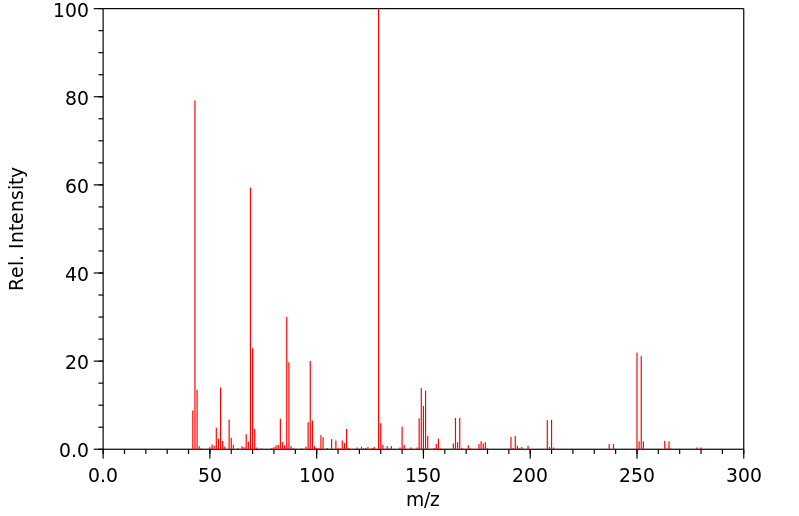乙酰溴米那 | 77-66-7
中文名称
乙酰溴米那
中文别名
N-乙醯-N-溴二乙基乙醯脲;阿巴辛;4-甲磺酰基苯肼盐酸盐
英文名称
acetylcarbromal
英文别名
Acecarbromal;N-acetyl-N'-(2-ethyl-2-bromo-butyryl)-urea;N-Acetyl-N'-(2-aethyl-2-brom-butyryl)-harnstoff;N-Acetyl-N'-bromdiaethylacetyl-harnstoff;Acetyladalin;N-(acetylcarbamoyl)-2-bromo-2-ethylbutanamide
CAS
77-66-7
化学式
C9H15BrN2O3
mdl
——
分子量
279.134
InChiKey
SAZUGELZHZOXHB-UHFFFAOYSA-N
BEILSTEIN
——
EINECS
——
-
物化性质
-
计算性质
-
ADMET
-
安全信息
-
SDS
-
制备方法与用途
-
上下游信息
-
文献信息
-
表征谱图
-
同类化合物
-
相关功能分类
-
相关结构分类
物化性质
-
熔点:108-109°
-
密度:1.5941 (rough estimate)
计算性质
-
辛醇/水分配系数(LogP):2.3
-
重原子数:15
-
可旋转键数:3
-
环数:0.0
-
sp3杂化的碳原子比例:0.67
-
拓扑面积:75.3
-
氢给体数:2
-
氢受体数:3
安全信息
-
储存条件:库房应保持通风、低温和干燥的环境。
SDS
制备方法与用途
上下游信息
-
上游原料
中文名称 英文名称 CAS号 化学式 分子量 乙溴酰脲 carbromal 77-65-6 C7H13BrN2O2 237.096
文献信息
-
Nitric Oxide Releasing Prodrugs of Therapeutic Agents申请人:SATYAM Apparao公开号:US20110263526A1公开(公告)日:2011-10-27The present invention relates to nitric oxide releasing prodrugs of known drugs or therapeutic agents which are represented herein as compounds of formula (I) wherein the drugs or therapeutic agents contain one or more functional groups independently selected from a carboxylic acid, an amino, a hydroxyl and a sulfhydryl group. The invention also relates to processes for the preparation of the nitric oxide releasing prodrugs (the compounds of formula (I)), to pharmaceutical compositions containing them and to methods of using the prodrugs.
-
Technology for the Preparation of Microparticles申请人:Malakhov Michael公开号:US20090098207A1公开(公告)日:2009-04-16Microspheres are produced by contacting a solution of a macromolecule or small molecule in a solvent with an antisolvent and a counterion, and chilling the solution. The microspheres are useful for preparing pharmaceuticals, nutraceuticals, cosmetic products and the like of defined dimensions.微球是通过将溶液中的大分子或小分子与抗溶剂和对离子接触,并冷却溶液而制备的。这些微球可用于制备具有明确定义尺寸的药物、营养保健品、化妆品等产品。
-
[EN] METHOD AND REAGENTS FOR N-ALKYLATING UREIDES<br/>[FR] PROCEDE ET REACTIFS DE N-ALKYLATION D'UREIDES申请人:TARO PHARMACEUTICAL INDUSTRIES LTD.公开号:WO1999018084A1公开(公告)日:1999-04-15(EN) A method of N-alkoxyalkylating ureides according to the invention comprises reacting a ureide of structure (I) with an alkylating agent of structure (III) in the presence of a basic catalyst in an aprotic reaction medium. The ureide may be a 5,5-disubstituted barbituric acid, or it may be phenytoin, glutethimide, and ethosuximide. The alkylating agent is an ester of a sulfonic acid. The base may be hydride or amine. A preferred process comprises N-alkoxyalkylating 5,5-diphenyl-barbituric acid with methoxymethyl methanesulfonate in the presence of di-isopropyl ethyl amine and isolating the resultant N,N'-bismethoxymethyl-5,5-diphenyl-barbituric acid. The invention also contemplates the novel compounds N-methoxymethyl-5,5-diphenylbarbituric acid, N-methoxymethyl ethosuximide, and N-methoxymethyl glutethimide, and a method comprising administering them to a patient.(FR) Ce procédé de N-alcoxy-alkylation d'uréides consiste à faire réagir un uréide correspondant à la structure (I) avec un agent d'alkylation correspondant à la structure (III), en présence d'un catalyseur de base, dans un milieu de réaction aprotique. L'uréide peut être un acide barbiturique disubstitué en position 5,5, ou il peut être phénytoïne, glutéthimide ou éthosuximide. L'agent d'alkylation est un ester de l'acide sulfonique. La base peut être un hydrure ou une amine. Un procédé préféré consiste à N-alcoxy-alkyler de l'acide 5,5-diphényl-barbiturique à l'aide de méthanesulfonate de méthoxyméthyle, en présence d'une di-isopropyle éthylamine, et à isoler l'acide N,N'-bisméthoxyméthyl-5,5-diphényl-barbiturique résultant. L'invention concerne également des nouveaux composés comme l'acide N-méthoxyméthyl-5,5-diphénylbarbiturique, le N-méthoxyméthyléthosuximide et le N-méthoxyméthylglutéthimide, ainsi qu'un procédé d'administration de ces substances à un patient.
-
N-methoxymethyl-5,5-diphenylbarbituric acid申请人:Taro Pharmaceutical Industries Ltd.公开号:US20030018080A1公开(公告)日:2003-01-23A method of N-alkoxyalkylating ureides according to the invention comprises reacting a ureide of structure I 1 with an alkylating agent of structure III 2 in the presence of a basic catalyst in an aprotic reaction medium. The ureide may be a 5,5-disubstituted barbituric acid, or it may be phenytoin, glutethimide, and ethosuximide. The alkylating agent is an ester of a sulfonic acid. The base may be a hydride or amine. A preferred process comprises N-alkoxyalkylating 5,5-diphenyl-barbituric acid with methoxymethyl methanesulfonate in the presence of di-isopropyl ethyl amine and isolating the resultant N,N′-bismethoxymethyl-5,5-diphenyl-barbituric acid. The invention also contemplates the novel compounds N-methoxymethyl-5,5-diphenylbarbituric acid, N-methoxymethyl ethosuximide, and N-methoxymethyl glutethimide, and a method comprising administering them to a patient.
-
Compositions and methods to effect the release profile in the transdermal administration of active agents申请人:——公开号:US20020004065A1公开(公告)日:2002-01-10Compositions and methods for the transdermal delivery of active agents up to a period of seven days or more at substantially a zero-order release rate comprising a pharmaceutically acceptable adhesive matrix and a polymeric plastic material that provides a release rate regulating effect on the active agents.本发明涉及一种用于经皮递送活性药剂的组合物和方法,该组合物和方法能够在持续时间为七天或更长时间内以几乎零阶释放速率递送活性药剂,包括一种药学上可接受的粘合基质和一种聚合物塑料材料,该聚合物塑料材料对活性药剂具有释放速率调节作用。
表征谱图
-
氢谱1HNMR
-
质谱MS
-
碳谱13CNMR
-
红外IR
-
拉曼Raman
-
峰位数据
-
峰位匹配
-
表征信息
同类化合物
顺式-4-[(甲基氨基甲酰)氨基]环己烷羧酸
顺式-3-己烯醇碳酸甲酯
镏碳酸盐二水
镍,[碳酸(2-)-κO]-
镁(1-甲基-3-氧代-丁-1-烯基)碳酸氢酯
锌氮烷碳酸盐
锆碳酸盐氧化物
锂(1-羧基环丙基)锂
铵铜碳酸盐
铯碳酸氢钠
铝镁加
铝镁加
铝碳酸镁
铝碳酸镁
钠脲氯酸盐
钠甲基碳酸酯
钙钠碳酸氢盐氟化物
钙四镁钠碳酸氢盐三碳酸盐四氢氧化物
钐(+3)阳离子碳酸酯
重质碳酸镁
重碳酸钠-13C
酸氧(-2)阴离子铅杂亚酸碳
酮羧酸
邻苯二甲酸氢壬酯
过氧碳酸钠
过氧碳酸二钠盐
过氧碳酸,O,O'-1,6-亚己基-OO,OO'-二叔丁基酯
过氧化脲素
过氧化二碳酸双十四酯
过氧化二碳酸双十六酯
过氧化二碳酸二硬脂酰酯
过氧化二碳酸二环己酯
过氧化二碳酸二正丁酯
过氧化二碳酸二异丙酯
过氧化二碳酸二仲丁酯
过氧化二碳酸二乙酯
过氧化二碳酸二-3-甲氧基丁酯
过氧化二碳酸二(2-乙基己)酯
过氧化(2-乙基己基)碳酸叔戊酯
过氧二碳酸二十三烷酯
过氧二碳酸二丙基酯
达比加群酯杂质41
达比加群酯杂质22
达比加群杂质36
达比加群杂质19
辛酰脲
辛基辛氧基甲基碳酸酯
辛基脲
轻质碳酸镁
起始原料2杂质B







